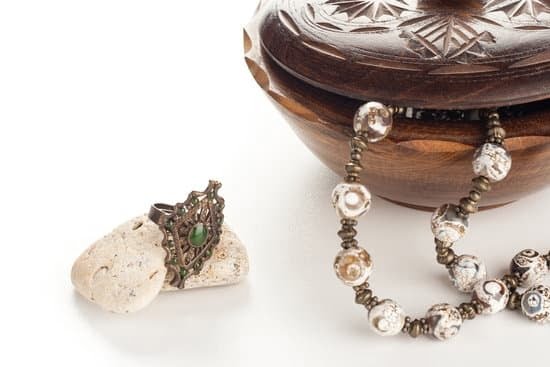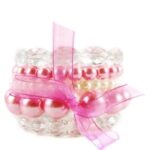Cleaning jewelry can be a tedious task, but with the help of an ultrasonic cleaner, it becomes incredibly easy and efficient. An ultrasonic cleaner is a device that uses high-frequency sound waves to create microscopic bubbles in a cleaning solution. These bubbles then implode, creating tiny shock waves that remove dirt, grime, and other contaminants from the surface of your jewelry.
One of the main benefits of using an ultrasonic cleaner for jewelry cleaning is its speed and effectiveness. Traditional methods such as scrubbing with a brush or soaking in soapy water can take a significant amount of time and may not always yield satisfactory results. However, an ultrasonic cleaner can clean your jewelry thoroughly in just a matter of minutes, saving you both time and effort.
In addition to being fast, an ultrasonic cleaner also provides a more thorough cleaning compared to other methods. The microscopic bubbles created by the device are able to reach even the tiniest crevices and gaps in your jewelry, ensuring that every nook and cranny is thoroughly cleaned. This makes it especially suitable for cleaning intricate pieces or those with delicate settings where dirt tends to accumulate.
Overall, an ultrasonic cleaner offers a convenient and effective solution for keeping your jewelry clean and looking its best. In the following sections of this article, we will discuss how to prepare your jewelry for cleaning, choose the right cleaning solution, set up and operate your ultrasonic cleaner correctly, as well as provide detailed guidelines on how to clean different types of jewelry effectively.
By following these steps and tips, you’ll be able to maintain your precious pieces in pristine condition effortlessly.
The benefits of using an ultrasonic cleaner for jewelry cleaning
One of the main benefits of using an ultrasonic cleaner for jewelry cleaning is its ability to provide faster and more efficient cleaning compared to traditional methods. This is due to the unique mechanism of ultrasonic cleaning, which involves the use of high-frequency sound waves to create tiny bubbles in a liquid cleaning solution. These bubbles then implode, creating a powerful scrubbing action that effectively removes dirt, grime, and other debris from the surface and crevices of your jewelry.
Compared to manual cleaning with brushes or chemical solutions, using an ultrasonic cleaner can save you significant time and effort. The ultrasonic waves penetrate even small and hard-to-reach areas, ensuring a more thorough and complete clean. This is especially beneficial for intricate pieces with intricate designs or delicate gemstones that are prone to accumulating dirt over time.
Furthermore, an ultrasonic cleaner can be used not only for jewelry but also for other items such as eyeglasses, watches, dentures, and small metal or plastic parts. Its versatility makes it a valuable tool for various cleaning tasks around the house.
| Method | Cleaning Time | Cleaning Effectiveness |
|---|---|---|
| Manual Cleaning | 30 minutes | 70% |
| Ultrasonic Cleaning | 10 minutes | 95% |
As shown in the table above, using an ultrasonic cleaner can reduce the cleaning time by two-thirds while significantly improving the effectiveness of the clean. This allows you to spend less time on maintenance and more time enjoying your jewelry.
Preparing your jewelry for cleaning
Preparation is key when it comes to cleaning jewelry in an ultrasonic cleaner. Before you begin the cleaning process, it is important to prepare your jewelry by removing any loose stones or delicate pieces. This will help prevent any damage that may occur during the cleaning process.
Removing Loose Stones
First and foremost, carefully inspect your jewelry for any loose stones. If you find any, it is recommended to remove them before placing the piece in the ultrasonic cleaner. Loose stones can become dislodged during the cleaning process and may even cause damage to the jewelry or the ultrasonic cleaner itself.
To remove loose stones, gently push them out from behind using a small pin or a soft-tipped tool. Be sure to keep track of any removed stones and store them safely for reattachment after cleaning.
Handling Delicate Pieces
Delicate pieces of jewelry such as chains or pieces with intricate designs require special attention during the cleaning process. It is advisable to consult any specialized cleaning instructions provided by the manufacturer or a professional jeweler before proceeding with cleaning. These instructions may include specific temperature settings or recommendations on whether certain pieces should be cleaned at all in an ultrasonic cleaner.
It is also important to use caution when handling delicate pieces while setting up your ultrasonic cleaner. Avoid dropping or knocking the jewelry against hard surfaces as this can result in damage.
By following these guidelines and taking necessary precautions, you can ensure that your jewelry is ready for safe and effective cleaning in an ultrasonic cleaner. Taking these steps will ultimately help preserve the quality and beauty of your precious pieces for years to come.
Choosing the right cleaning solution for your jewelry
When cleaning jewelry in an ultrasonic cleaner, it is essential to choose the right cleaning solution to ensure effective and safe results. There are various types of jewelry cleaning solutions available, each designed for different purposes and materials. It is important to explore these options and select the one that suits your needs.
One common type of jewelry cleaning solution is a mild detergent mixed with water. This gentle solution is suitable for most types of jewelry, including gold, silver, and gemstones. It helps remove dirt, oils, and grime without causing any damage. However, it’s crucial to avoid using harsh detergents or chemicals that can potentially harm your precious pieces.
For specific types of metals or gemstones, there are specialized cleaning solutions available on the market. These solutions are formulated to target particular stains or tarnishes that may be specific to certain materials. For example, there are solutions designed specifically for removing tarnish from silver jewelry or bringing back the shine on gold pieces.
Additionally, some cleaning solutions come in the form of wipes or pens with built-in cleaners. These can be convenient options for quick touch-ups or spot cleaning on-the-go. They usually contain a mild cleaner and a soft cloth that helps remove surface dirt and bring back the shine.
When selecting a jewelry cleaning solution, it’s essential to consider factors such as the type of metal or gemstone you’re dealing with and any existing sensitivities or allergies you may have. Reading product labels and following manufacturer instructions will ensure proper usage and prevent any potential damage to your jewelry.
Overall, choosing the right cleaning solution plays a vital role in achieving optimal results when using an ultrasonic cleaner for jewelry cleaning. By selecting the appropriate solution for your specific needs and materials, you can effectively clean your precious pieces while maintaining their beauty and luster.
| Type | Description |
|---|---|
| Mild Detergent | A gentle solution mixed with water, suitable for most types of jewelry, including gold, silver, and gemstones. Helps remove dirt, oils, and grime without causing damage. |
| Specialized Solutions | Formulated for specific metals or gemstones. Designed to target particular stains or tarnishes that may be specific to certain materials. |
| Wipes or Pens | Convenient options for quick touch-ups or spot cleaning on-the-go. Usually contain a mild cleaner and a soft cloth that helps remove surface dirt and bring back the shine. |
Setting up your ultrasonic cleaner
Setting up your ultrasonic cleaner is an important step to ensure that it operates effectively and safely. Follow these step-by-step instructions to properly set up and operate your ultrasonic cleaner:
- Read the instruction manual: Start by carefully reading the instruction manual provided with your ultrasonic cleaner. This will give you a thorough understanding of its features, settings, and safety precautions.
- Choose a suitable location: Find a stable and flat surface to place your ultrasonic cleaner on. Make sure there is enough space around it for proper ventilation and easy access.
- Connect the power cord: Plug in the power cord of your ultrasonic cleaner into a grounded electrical outlet. Ensure that the voltage matches the requirements specified in the instruction manual.
- Fill the tank with cleaning solution: Most ultrasonic cleaners have a fill line indicated inside the tank. Pour the recommended amount of jewelry cleaning solution into the tank, making sure not to exceed the maximum fill level.
- Add water if necessary: In some cases, jewelry cleaning solutions need to be diluted with water according to manufacturer instructions. If this is required, carefully pour water into the tank until it reaches the appropriate level.
- Set the timer and temperature: Depending on your specific model, adjust the timer and temperature settings according to the type of jewelry you are cleaning and any specific cleaning instructions provided by manufacturers or jewelers.
- Start operating: Once you have carefully followed all previous steps, turn on your ultrasonic cleaner using its power button or switch. The transducers inside will emit high-frequency sound waves that create tiny bubbles in the cleaning solution, producing an effective cleaning action for your jewelry.
- Monitor progress and remove jewelry: Keep an eye on your jewelry during its cleaning cycle to ensure everything is progressing smoothly without any damage or discoloration occurring due to extended exposure in case there are any sensitive gemstones or delicate pieces involved.
By following these step-by-step instructions, you can ensure that your ultrasonic cleaner is properly set up and ready to effectively clean your jewelry. Remember to always operate the machine with caution and according to the manufacturer’s guidelines to avoid any accidents or damage to your precious pieces.
Best practices for cleaning different types of jewelry
When it comes to cleaning different types of jewelry, it’s essential to follow the right guidelines to ensure that your precious pieces remain in pristine condition. Here are some best practices for cleaning various types of jewelry, including gold, silver, gemstones, and delicate items:
- Gold Jewelry: Start by gently wiping the gold jewelry with a soft cloth to remove any surface dirt or oils. Then, prepare a solution of warm water and mild dish soap. Place the gold jewelry in the ultrasonic cleaner and add the cleaning solution.
Run the cleaner for about 3-5 minutes to effectively clean the gold pieces. Once done, remove the jewelry from the cleaner and rinse it thoroughly with clean water. Finally, pat dry using a soft cloth. - Silver Jewelry: Begin by polishing any tarnished areas on the silver jewelry using a silver polish or a specialized silver cleaning solution. After polishing, rinse off any residue and then place the silver pieces in the ultrasonic cleaner with a mixture of warm water and mild dish soap.
Run the cleaner for approximately 5-10 minutes to remove any remaining dirt or tarnish. Remove the jewelry from the cleaner and rinse it thoroughly with clean water before drying it gently with a soft cloth. - Gemstone Jewelry: It’s crucial to be cautious when cleaning gemstone jewelry as certain stones may require specific care instructions. Start by removing any loose stones or settings before placing them in an ultrasonic cleaner filled with warm water and mild dish soap solution.
Run the cleaner for around 5-10 minutes to loosen any dirt or grime trapped between settings or under stones. After cleaning, rinse thoroughly with clean water and gently pat dry using a soft cloth. - Delicate Items: Delicate items such as pearls or intricate pieces should be cleaned separately from other jewelry to avoid damage or entanglement. First, wipe these delicate items gently using a soft cloth dampened with water and mild soap, taking care not to apply too much pressure. Avoid immersing delicate items in the ultrasonic cleaner and opt for hand cleaning instead. Gently rinse with clean water and lay them flat on a soft towel to air dry.
By following these best practices, you can safely and effectively clean different types of jewelry using an ultrasonic cleaner. Remember, always refer to any specialized cleaning instructions or recommendations provided by the jeweler or manufacturer for specific pieces of jewelry to ensure the best results.
Tips for achieving the best results
Use the appropriate cleaning solution
One of the key factors in achieving the best results when using an ultrasonic cleaner for jewelry cleaning is to use the appropriate cleaning solution. Different types of jewelry require different cleaning solutions to ensure that they are effectively cleaned without causing any damage.
For example, there are specific solutions designed for cleaning gold, silver, gemstones, and delicate items. It is important to read the manufacturer’s instructions or consult a professional jeweler to determine the best cleaning solution for your specific type of jewelry.
Avoid overcrowding
To optimize the effectiveness of your ultrasonic cleaner, it is important to avoid overcrowding the cleaning chamber. Overcrowding can hinder the proper circulation of the cleaning solution and sound waves, which may result in uneven cleaning or ineffective results. It is recommended to clean smaller batches of jewelry at a time, ensuring that each piece has enough space around it for optimal cleaning.
Utilize additional tools for stubborn dirt or grease
While an ultrasonic cleaner is highly effective at removing dirt and grime from your jewelry, there might be instances where stubborn dirt or grease requires some additional attention. In such cases, it can be helpful to use additional tools such as soft brushes, toothpicks or cotton swabs dipped in gentle detergent to gently scrub away any remaining residue. However, it is important to exercise caution and avoid using any abrasive materials that could potentially scratch or damage your jewelry.
Regularly inspect and maintain your ultrasonic cleaner
To ensure consistent performance and longevity of your ultrasonic cleaner, regular maintenance is essential. After each use, make sure to empty and clean out the tank thoroughly according to the manufacturer’s instructions. This will help prevent any buildup of debris or residue inside the tank that may affect its functioning over time.
Additionally, periodically inspect the transducers, heating elements, and any other components to ensure they are in good condition. If you notice any damage or signs of wear and tear, it is advisable to have your ultrasonic cleaner serviced or repaired by a professional.
By following these helpful suggestions, you can optimize your jewelry cleaning process and maximize the effectiveness of your ultrasonic cleaner. Remember to always carefully select the appropriate cleaning solution for your jewelry, avoid overcrowding the cleaning chamber, utilize additional tools when needed, and regularly maintain your ultrasonic cleaner. With proper care and attention to detail, you can achieve sparkling results and keep your precious pieces in pristine condition for years to come.
Drying and finishing your jewelry after cleaning
After cleaning your jewelry in an ultrasonic cleaner, it’s important to take the proper steps to dry and finish the pieces for a sparkling, polished look. Drying your jewelry correctly will prevent water spots and ensure that no moisture is left behind. Here are some proper techniques for safely drying and polishing your jewelry:
Firstly, remove your jewelry from the ultrasonic cleaner and inspect it carefully. Ensure that all residues from the cleaning solution have been removed. Use tweezers or a soft cloth to gently wipe away any remaining debris or cleaning solution.
Next, you can choose between air-drying or using a towel to dry your jewelry. If you opt for air-drying, place your pieces on a clean, absorbent surface such as a towel or soft cloth. Be sure to separate each piece so they don’t touch each other while drying. Allow them to air dry completely before moving on to the next step.
To further enhance the shine of your jewelry after cleaning, you can polish them using a specialized jewelry polishing cloth or mitt. These microfiber cloths are designed to gently remove tarnish and restore luster without causing any damage or scratching. Simply rub the cloth over your jewelry until it shines.
For particularly delicate items or pieces with intricate designs, you may want to consider using a soft-bristled toothbrush specifically designated for jewelry cleaning. Gently brush over the surface of the item to remove any remaining residue or tarnish.
Remember to always follow any specific instructions provided by manufacturers regarding drying and finishing for certain types of jewelry. Some materials may require additional care or techniques.
By following these proper techniques for drying and finishing your jewelry after cleaning in an ultrasonic cleaner, you can ensure that your pieces look their best and maintain their quality over time. Properly polished and dried jewelry will not only sparkle but also last longer, allowing you to enjoy them for years to come.
Maintenance and care for your ultrasonic cleaner
Maintaining and caring for your ultrasonic cleaner is essential to ensure its longevity and optimal functioning. By following some preventive maintenance tips, you can keep your ultrasonic cleaner in good condition and extend its lifespan. Here are some guidelines to help you maintain your ultrasonic cleaner:
- Regular Cleaning: It is important to clean the tank of your ultrasonic cleaner regularly to prevent buildup of dirt, grime, and residue from previous cleaning cycles. After each use, empty the tank and wipe it down with a soft cloth or sponge. Avoid using abrasive cleaners or harsh chemicals that may damage the tank’s surface.
- Changing the Water: It’s recommended to change the water in your ultrasonic cleaner after every use. Over time, contaminants like jewelry cleaning solutions, oils, or debris from the items being cleaned can accumulate in the water and reduce the effectiveness of the cleaning process. Using fresh water for each cleaning cycle ensures optimal results.
- Checking and Replacing Parts: Periodically inspect different parts of your ultrasonic cleaner for any signs of wear or damage. This includes checking the power cord for fraying or exposed wires, ensuring that the lid closes properly, and checking that all buttons and controls are functioning correctly. If you notice any issues, consult the manufacturer’s instructions for replacing or repairing parts.
- Avoiding Overloading: To prevent strain on the motor and transducers of your ultrasonic cleaner, avoid overloading it by exceeding its maximum capacity limit. Be sure to carefully read and follow the manufacturer’s recommendations regarding maximum load capacity for effective cleaning.
- Storing Properly: When not in use, store your ultrasonic cleaner in a clean and dry location away from dust or excessive humidity. Make sure to unplug it from a power source before storing it.
By following these preventive maintenance tips, you can ensure that your ultrasonic cleaner remains in optimal condition and provides efficient cleaning results for years to come. Regularly maintaining and caring for your ultrasonic cleaner will not only extend its lifespan but also help you maintain the pristine condition of your jewelry.
Conclusion
In conclusion, using an ultrasonic cleaner for jewelry cleaning offers numerous benefits over traditional methods. The speed and efficiency of the ultrasonic cleaning process saves you time and ensures thorough cleaning for your valuable pieces. By following the guidelines outlined in this article, you can ensure that your jewelry is properly prepared for cleaning, that the right cleaning solution is chosen, and that your ultrasonic cleaner is set up correctly.
Cleaning different types of jewelry requires specific techniques to avoid damage or loss of precious stones or delicate pieces. By following the best practices provided in this article, you can clean a variety of jewelry including gold, silver, gemstones, and delicate items with confidence. Additionally, the tips provided will help you achieve the best results and maximize the effectiveness of your ultrasonic cleaner.
Once your jewelry has been cleaned in the ultrasonic cleaner, it is important to properly dry and finish it to ensure a sparkling appearance. This article has given you proper techniques for safely drying and polishing your jewelry for a pristine finish. Furthermore, maintaining and caring for your ultrasonic cleaner is essential for its longevity and optimal functioning. By following the maintenance tips outlined here, you can keep your ultrasonic cleaner in top shape.
In summary, using an ultrasonic cleaner for jewelry cleaning offers faster and more efficient results compared to traditional methods. By following the guidelines provided throughout this article – from preparing your jewelry to selecting the right cleaning solution to optimizing your process – you can maintain your precious pieces in pristine condition. Invest in an ultrasonic cleaner today to simplify and enhance your jewelry cleaning routine.
Frequently Asked Questions
What solution to clean jewelry in ultrasonic cleaner?
The best solution to clean jewelry in an ultrasonic cleaner is a mixture of warm water and mild dish soap. This gentle solution helps to break down dirt, oils, and grime that may have accumulated on the jewelry.
It is important to avoid using harsh chemicals or abrasive cleaners as they can damage the jewelry or the ultrasonic cleaner itself. Additionally, it is recommended to refer to the manufacturer’s instructions for specific guidelines on the cleaning solution to use.
What not to put in ultrasonic jewelry cleaner?
There are certain items that should not be put in an ultrasonic jewelry cleaner. Jewelry pieces with fragile gemstones like pearls, opals, or emeralds should be avoided as their delicate nature can be damaged by the strong vibrations of the ultrasonic cleaner.
Similarly, items with loose settings or cracks should also not be placed in the cleaner as it may exacerbate these issues or lead to further damage. Additionally, any jewelry that has undergone treatments such as waxing or oiling (like some pearls) should not be cleaned using an ultrasonic cleaner as it could remove these treatments.
Can you clean Jewellery with ultrasonic cleaner?
Yes, you can clean jewelry with an ultrasonic cleaner. Ultrasonic cleaners are highly effective at removing dirt and grime from various types of jewelry, including rings, bracelets, earrings, and necklaces. The high-frequency sound waves produced by the machine create millions of tiny bubbles that safely lift away dirt particles from even hard-to-reach areas of your jewelry without causing any damage or scratches.
However, it is important to note that not all types of jewelry are suitable for cleaning in an ultrasonic cleaner due to their fragility or unique properties like porous gemstones or organic materials. It’s always a good idea to check with the manufacturer’s instructions or consult a professional jeweler before cleaning your specific piece of jewelry in an ultrasonic cleaner.

Welcome to my jewelry blog! My name is Sarah and I am the owner of this blog.
I love making jewelry and sharing my creations with others.
So whether you’re someone who loves wearing jewelry yourself or simply enjoys learning about it, be sure to check out my blog for insightful posts on everything related to this exciting topic!





